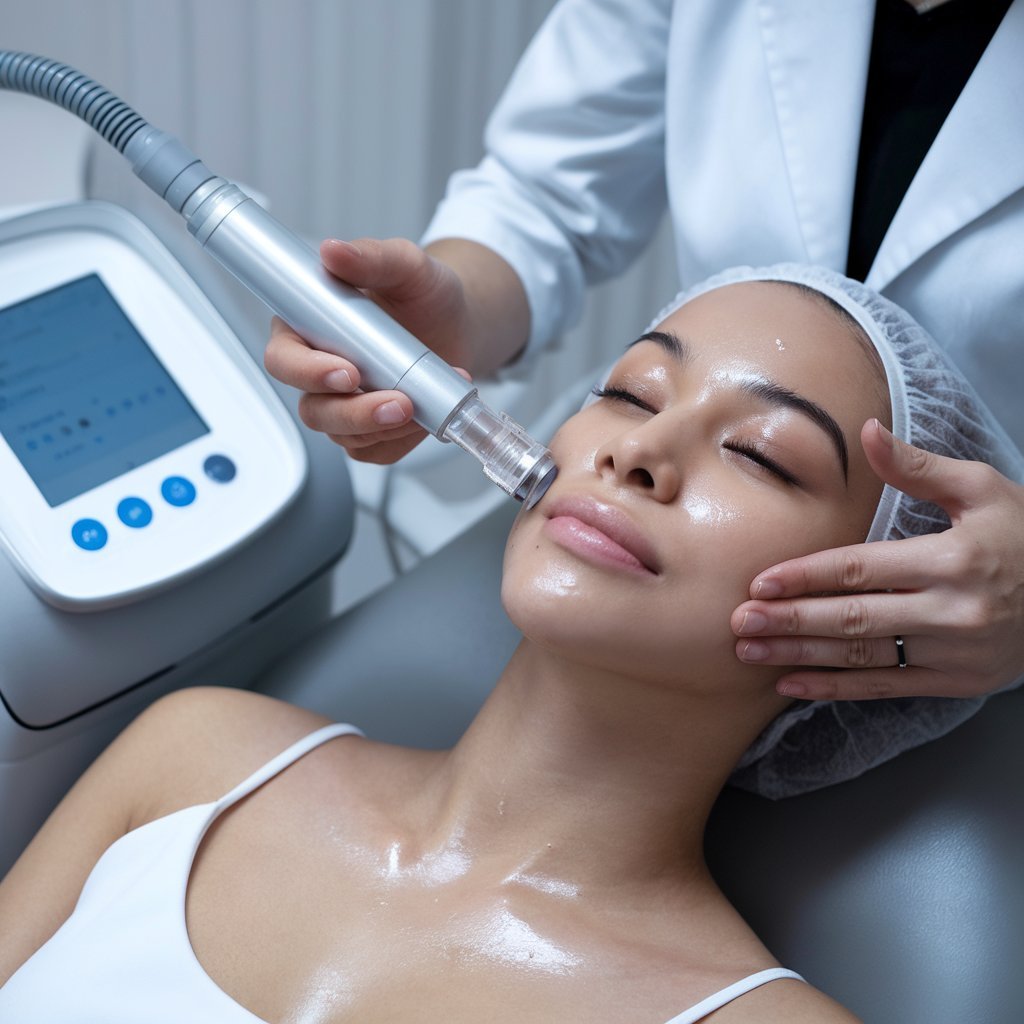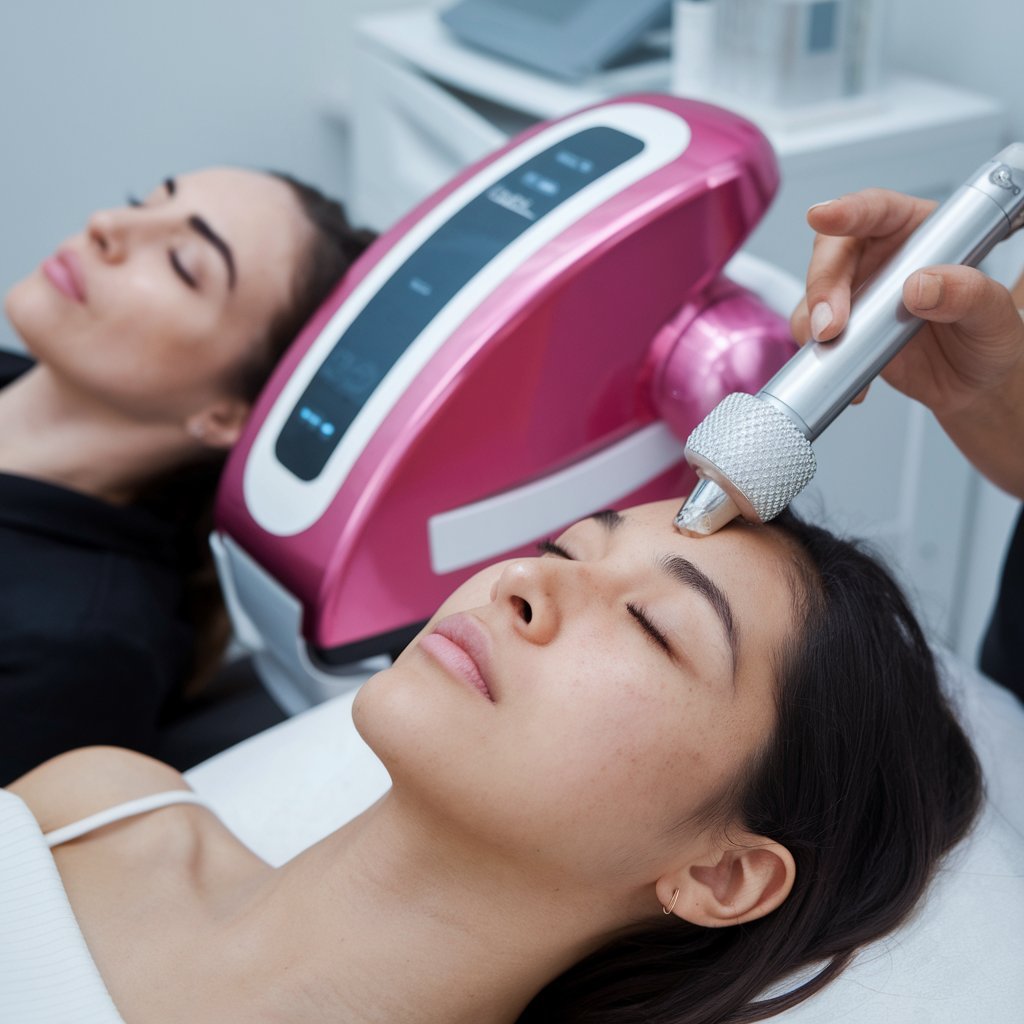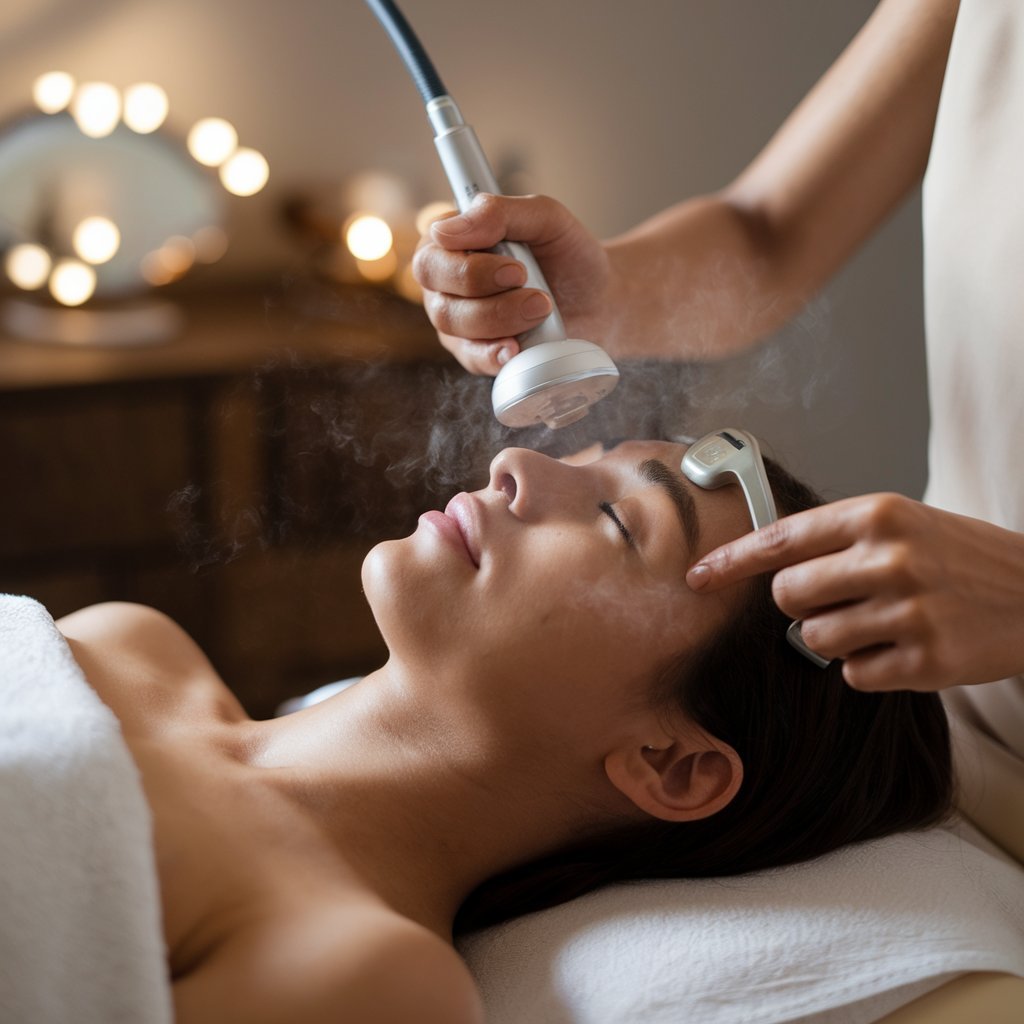Comparing Hydrafacial Vs Microdermabrasion in Skin Treatments
- Home
- Skin Rejuvenation
- hydrafacial vs microdermabrasion

HydraFacial and microdermabrasion are effective skincare treatments with distinct mechanisms. HydraFacial utilizes Vortex-Fusion technology for thorough cleansing and antioxidant infusion, providing hydration suitable for sensitive skin with minimal downtime. Microdermabrasion employs mechanical exfoliation, enhancing skin texture and collagen production, but may not suit hypersensitive skin due to its abrasive nature. HydraFacial particularly excels in treating acne scars without irritation, whereas microdermabrasion effectively targets deeper scars. Explore further to understand ideal treatment approaches for specific concerns.
Key Takeaways
- HydraFacial offers a gentle and customizable approach that is suitable for all skin types, including sensitive skin, with minimal irritation and downtime.
- Microdermabrasion provides more effective results for deeper acne scars but may not suit hypersensitive skin due to its abrasive nature.
- HydraFacial combines cleansing, exfoliation, extraction, and hydration, optimizing skin luminosity and targeting specific concerns while maintaining hydration.
- Microdermabrasion promotes cellular regeneration and collagen production through physical exfoliation, improving texture and reducing fine lines.
- Combining HydraFacial and microdermabrasion can enhance hydration, collagen production, and overall skin health for improved luminosity and texture.
What is a HydraFacial?
The HydraFacial is a non-invasive skincare treatment that combines cleansing, exfoliation, extraction, hydration, and antioxidant protection simultaneously.
Peer-reviewed studies have demonstrated its efficacy in addressing a range of skin concerns, including fine lines, enlarged pores, and hyperpigmentation.
Additionally, the treatment is considered suitable for all skin types due to its customizable nature and gentle approach.
Understanding the HydraFacial Treatment Process
When exploring advanced skincare treatments, a HydraFacial emerges as a non-invasive procedure designed to rejuvenate and revitalize the skin through a multi-step process.
The hydrafacial treatment begins by exfoliating the skin’s surface, removing dead skin cells to promote a smoother texture. Utilizing a unique hydrafacial procedure, it employs a vortex-fusion technology that simultaneously extracts impurities from the skin and infuses them with a specialized serum.
This serum is tailored to hydrate the skin, delivering essential nutrients that support healthy skin. The process is meticulously engineered to be suitable for all skin types, ensuring wide applicability in skin care.
Objective evidence highlights the hydrafacial’s efficacy in improving skin appearance, making it a reliable choice for individuals seeking a thorough skincare solution.
Benefits of HydraFacial for Skin Concerns
As skincare innovations continue to advance, HydraFacial stands out for its ability to address various skin concerns effectively. The HydraFacial process integrates exfoliation, extraction, and hydration in a single treatment, improving skin health.
Scientifically, it targets specific skin concerns such as fine lines and acne by unclogging pores and removing impurities. This multifunctional approach enhances skin texture and tone, resulting in glowing skin.
Clinical studies demonstrate that regular HydraFacial treatments decrease pore size and improve the appearance of fine lines, contributing to a rejuvenated complexion.
Additionally, its gentle yet thorough exfoliation method is beneficial for maintaining healthy skin without irritation. Evidence suggests that HydraFacial is a robust option for those seeking extensive care for diverse skin concerns.
Is HydraFacial Suitable for All Skin Types?
Exploring the versatility of HydraFacial, a question arises regarding its suitability across various skin types. Evidence suggests HydraFacial is a gentler option compared to microdermabrasion, as it effectively removes dead skin cells while minimizing irritation.
This facial treatment is designed to cater to diverse skin concerns, including sensitivity, acne, and aging, making it potentially the best option for your skin regardless of type.
Unlike microdermabrasion, which may not be ideal for sensitive or acne-prone skin, HydraFacial offers hydration and exfoliation without abrasive techniques.
Research supports the benefits of HydraFacial, highlighting its adaptability and effectiveness in addressing a wide range of skin types.
Consequently, when considering HydraFacial vs microdermabrasion, the former appears to be more inclusive and accommodating for all individuals.

How Does Microdermabrasion Work?
Microdermabrasion is a minimally invasive procedure that exfoliates the skin’s outermost layer using either fine crystals or a diamond-tipped wand, promoting cell turnover and enhancing skin texture.
Studies have shown that this technique can improve skin health by reducing the appearance of fine lines, hyperpigmentation, and minor scars.
The choice between crystal and diamond microdermabrasion techniques depends on the desired intensity and specific skin concerns, with both methods demonstrating efficacy in clinical settings.
The Microdermabrasion Procedure Explained
The microdermabrasion procedure employs a minimally abrasive instrument to gently exfoliate the skin, removing the thicker, uneven outer layer.
This method of skin resurfacing is designed to remove dead skin cells from the top layer of skin, aiming to improve texture and appearance.
Two main techniques exist: diamond microdermabrasion and crystal microdermabrasion. Each employs different tools but seeks to achieve similar outcomes in skin refinement.
- Diamond microdermabrasion uses a diamond-tipped wand to abrade the skin.
- Crystal microdermabrasion involves spraying fine crystals across the skin’s surface.
Microdermabrasion treatment targets issues such as fine lines, wrinkles, and uneven skin tone.
Microdermabrasion Benefits for Skin Health
While the procedure of microdermabrasion has been outlined, understanding its benefits for skin health reveals why it is a popular choice for many. This skin treatment effectively resurfaces the outer layer of skin, addressing uneven skin tone and texture. By removing dead cells, microdermabrasion benefits include reducing the appearance of acne scars, wrinkles, and signs of aging skin. It serves to tackle specific skin concerns, promoting a smoother and rejuvenated appearance.
Benefit | Description |
Skin Resurfacing | Removes the outer layer of skin |
Improved Skin Tone | Addresses uneven skin and texture |
Reduction of Imperfections | Diminishes acne scars and wrinkles |
Understanding Crystal Microdermabrasion vs. Diamond Techniques
Differentiating between crystal and diamond microdermabrasion techniques offers insight into how these popular exfoliation methods work to rejuvenate the skin.
Crystal microdermabrasion employs fine crystals to abrade the outer layer of skin, effectively addressing skin problems like uneven texture. In contrast, diamond microdermabrasion uses a diamond-tipped wand to exfoliate, offering precise control and reducing skin issues such as fine lines and scars.
- Crystal microdermabrasion: Utilizes microcrystals to exfoliate, improving the texture of the skin.
- Diamond microdermabrasion: Employs a diamond-tipped wand for targeted exfoliation, addressing specific skin issues.
- Comparing hydra facial: This type of facial combines hydration with exfoliation, differentiating from the mechanical nature of microdermabrasion.
Both techniques offer the benefits of microdermabrasion by promoting cell turnover and enhancing skin health.
HydraFacial vs Microdermabrasion: Which is Better for Acne?
In evaluating the effectiveness of HydraFacial or Microdermabrasion for acne, it is essential to contemplate their impact on acne scars, oily skin, and uneven skin tone.
Clinical evidence suggests that HydraFacial may offer superior results in reducing acne scars due to its hydrating and exfoliating properties that also help balance oily skin.
Conversely, Microdermabrasion is recognized for its ability to improve skin texture, though its efficacy in addressing deeper acne scars is less pronounced.
Comparing HydraFacial and Microdermabrasion for Acne Scars
When evaluating the efficacy of skin treatments for acne scars, particularly HydraFacial and Microdermabrasion, it is essential to contemplate their mechanisms of action and scientific evidence.
Both treatments aim to rejuvenate the skin but employ different techniques. HydraFacial combines cleansing, exfoliation, extraction, and hydration to address various skin concerns, while Microdermabrasion uses abrasive particles to remove the outer layer of the skin, promoting regeneration.
- HydraFacial vs Microdermabrasion: HydraFacial often results in less downtime, offering a more comfortable hydrafacial experience.
- Acne scars: Microdermabrasion may provide more effective results for deeper acne scars, enhancing skin texture.
- Oily skin: HydraFacial can be advantageous for oily skin, as it deeply cleanses and hydrates.
Selecting the best treatment depends on individual skin needs and desired outcomes.

Tackling Oily Skin and Uneven Skin Tone
Evaluating the efficacy of HydraFacial and Microdermabrasion for acne not only involves considering their impact on scars but also extends to addressing oily skin and uneven skin tone.
HydraFacial MD delivers a multifaceted approach, using a patented vortex technology to cleanse, exfoliate, and hydrate, targeting the superficial layer of your skin. This results in reduced oil production and improved skin texture.
In contrast, diamond microdermabrasion offers a mechanical exfoliation method, effectively removing dead skin cells and minimizing the appearance of uneven skin tone.
When considering hydrafacial vs microdermabrasion, it’s essential to assess the skin’s needs. While microdermabrasion facial treatments focus on physical exfoliation, hydrafacial and microdermabrasion treatments together may offer thorough solutions for oily skin and tone irregularities.
Best Results for Acne with Facial Treatments
How do HydraFacial and Microdermabrasion compare in terms of their effectiveness in treating acne? Both treatments offer unique benefits for acne-prone skin.
HydraFacial combines cleansing, exfoliation, extraction, and hydration, effectively reducing acne by unclogging pores and infusing moisture. In contrast, microdermabrasion, specifically diamond microdermabrasion, exfoliates the skin using diamond-tipped instruments, which may be less suitable for sensitive, acne-prone skin due to its abrasive nature.
Key considerations include:
- Combination of Treatments: A combination of microdermabrasion and a chemical peel can be more effective for certain acne types.
- Cost Considerations: The HydraFacial cost varies depending on the type and provider, with premium options like the platinum HydraFacial generally being more expensive than microdermabrasion.
- Skin Sensitivity: Compared to microdermabrasion, getting a HydraFacial might be gentler on the skin, making it ideal for acne sufferers.
What are the Downtime and Side Effects?
When considering the downtime and side effects associated with HydraFacial and microdermabrasion, evidence suggests notable distinctions between the two.
HydraFacial typically requires minimal recovery time, with patients often able to resume normal activities immediately.
In contrast, microdermabrasion may lead to temporary redness and mild irritation, indicating a slightly longer recovery period.
Comparative studies highlight that while both treatments are generally well-tolerated, microdermabrasion carries a higher risk of transient side effects.
Exploring Downtime After a HydraFacial Process
Although HydraFacial is often lauded for its minimal downtime, understanding the process and potential side effects is essential for setting realistic expectations.
Typically, individuals can resume their daily activities immediately following the treatment. This is attributable to the non-invasive nature of the procedure, which combines cleansing, exfoliation, extraction, and hydration in a single session.
However, even with minimal invasiveness, some considerations are necessary:
- Transient Redness: Post-procedure redness may occur, typically subsiding within a few hours.
- Sensitivity: Skin sensitivity might increase temporarily, necessitating sunscreen application and gentle skincare.
- Mild Swelling: Some individuals report mild swelling, which generally resolves without intervention.
These effects are generally short-lived, allowing the HydraFacial to fit seamlessly into most schedules without significant disruption.
Potential Side Effects of Microdermabrasion
Microdermabrasion, a mechanical exfoliation technique, carries potential side effects that individuals should consider before undergoing the procedure.
The process involves the removal of the stratum corneum, the outermost skin layer, which may result in temporary redness and sensitivity. Research indicates that some individuals experience mild erythema and a sensation similar to sunburn.
Additionally, the procedure may lead to minor swelling and bruising due to the abrasive action on the skin. In rare cases, microdermabrasion can exacerbate pre-existing skin conditions such as rosacea or acne, increasing inflammation and irritation.
Individuals with hypersensitive skin need to consult a dermatologist to assess suitability. Overall, while microdermabrasion is generally safe, awareness of potential side effects is vital for informed decision-making.
Comparing Recovery Time: HydraFacial vs Microdermabrasion
Considering the potential side effects associated with microdermabrasion, a comparative analysis of recovery times and side effects between HydraFacial and microdermabrasion becomes pertinent.
Microdermabrasion often entails a longer recovery period due to its abrasive nature, which may cause redness and irritation lasting several days. Conversely, HydraFacial is associated with minimal downtime, allowing individuals to resume normal activities immediately post-treatment.
The following points highlight key differences:
- Downtime: HydraFacial typically requires no downtime, while microdermabrasion may necessitate a few days for redness to subside.
- Side Effects: While HydraFacial rarely causes adverse effects, microdermabrasion may lead to temporary skin sensitivity.
- Suitability: HydraFacial is more suitable for all skin types, whereas microdermabrasion might not be ideal for sensitive skin.
This evidence underscores HydraFacial’s efficiency in minimizing recovery constraints.
Enhancing Skin Care with HydraFacial and Microdermabrasion
HydraFacial and microdermabrasion are two distinct skin care treatments that can be integrated to address specific dermatological concerns such as fine lines, wrinkles, and uneven skin tone.
Scientific evidence suggests that HydraFacial provides effective hydration and exfoliation through a patented vortex technology, while microdermabrasion mechanically exfoliates the skin’s surface to promote cellular turnover.
Combining these treatments may enhance skin texture and luminosity, offering a thorough approach to achieving improved skin health and appearance. Before undergoing either or both treatments, seeking hydrafacial treatment preparation advice ensures optimal results and minimises potential skin sensitivity.
Integrating Treatments for Fine Lines and Wrinkles
How effectively can integrating HydraFacial and microdermabrasion treatments address fine lines and wrinkles?
Scientific evidence suggests that combining these treatments may enhance anti-aging results by leveraging their unique mechanisms.
Microdermabrasion employs mechanical exfoliation to remove dead skin cells, promoting cellular turnover, while HydraFacial infuses antioxidants and peptides, nourishing the skin.
The potential benefits of this integration include:
- Enhanced Skin Texture: The dual action of exfoliation and infusion can greatly improve skin smoothness.
- Increased Collagen Production: Stimulating collagen synthesis may lead to reduced appearance of fine lines, as reported in clinical studies.
- Optimized Hydration: HydraFacial’s hydration properties complement microdermabrasion’s exfoliation, maintaining skin moisture levels.
This integrated approach may provide a more thorough anti-aging solution, addressing multiple aspects of skin health.
Achieving Glowing Skin and Improved Skin Tone
Building on the synergistic effects of HydraFacial and microdermabrasion in addressing fine lines and wrinkles, these treatments also show promise in achieving glowing skin and improved skin tone.
Scientific evidence indicates that HydraFacial utilizes a unique vortex technology to cleanse and hydrate, which enhances skin luminosity by increasing circulation and nutrient delivery to the dermal layers.
Microdermabrasion, known for its exfoliating action, removes dead skin cells, promoting cellular regeneration and even skin tone.
Clinical studies have demonstrated improvements in skin radiance and texture following these treatments.
Both methods work synergistically to enhance the skin’s natural glow, attributed to enhanced epidermal turnover and improved vascularization.
As a result, patients often experience a more uniform and radiant complexion post-treatment.
How to Exfoliation and Hydrate the Skin Effectively
Effectively exfoliating and hydrating the skin is essential for maintaining ideal skin health and appearance.
HydraFacial and Microdermabrasion are two advanced treatments that offer significant benefits in this regard. HydraFacial uses a patented Vortex-Fusion technology, combining cleansing, exfoliation, extraction, and hydration, employing serums tailored to individual skin needs.
In contrast, Microdermabrasion uses fine crystals or a diamond-tipped wand to remove the top layer of skin, promoting cell turnover and collagen production.
Both methods are supported by scientific evidence:
- Hydration Impact: HydraFacial increases skin hydration and elasticity, as shown in clinical studies.
- Exfoliation Efficacy: Microdermabrasion enhances skin texture and smoothness by physically exfoliating the epidermis.
- Safety Profile: Both treatments are non-invasive with minimal recovery time, making them suitable for regular use.
Conclusion
In evaluating HydraFacial and microdermabrasion, both treatments offer unique benefits for skin rejuvenation. HydraFacial provides a gentle, hydrating approach with minimal side effects, making it suitable for sensitive skin. Microdermabrasion, by contrast, offers a more intensive exfoliation, which can be beneficial for those with thicker or more resilient skin. Evidence suggests that HydraFacial may be more effective for acne-prone individuals due to its hydrating and non-irritating properties. Ultimately, the choice depends on specific skin needs and individual tolerance for treatment intensity.

Highly skilled cosmetologist at Tune Clinical Aesthetics, specializing in advanced skin and hair treatments.





